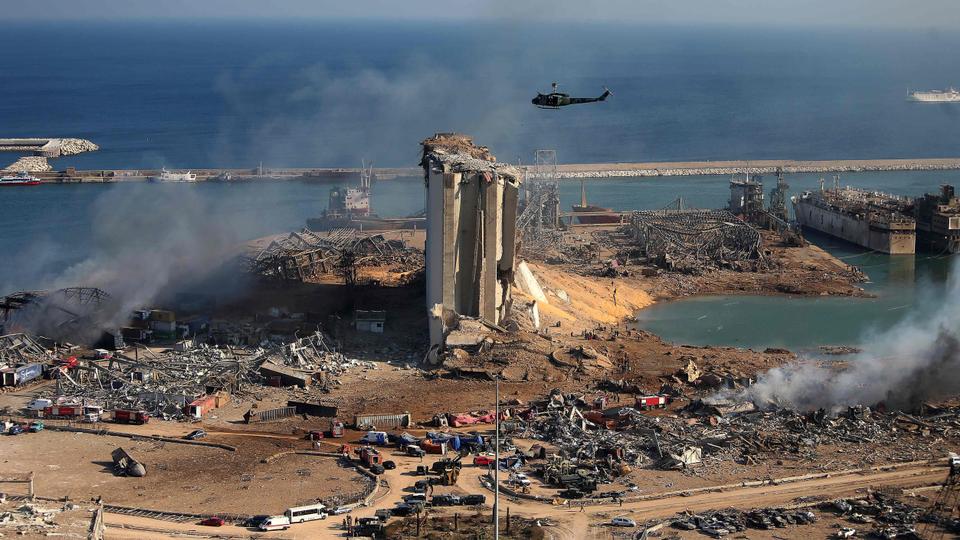AMMONIUM NITRATE
AMMONIUM NITRATE
Ammonium nitrate, which is used in fertilizers and in production of bombs, is a salt made from ammonium and nitric acid, and it is highly explosive. The more ammonium nitrate, or NH4-NO3, the bigger is its explosive capacity. As per the reports, there was Ammonium nitrate in tons, being stored at the port of Beirut since 2014.
Ammonium nitrate is frequently added to increase a fertilizer’s nitrogen content. It’s relatively stable under most circumstances and is inexpensive to manufacture, making the chemical a popular alternative in comparison to other expensive nitrogen sources.
With all the pros, ammonium nitrate has a potentially lethal downside too: The compound is considered an oxidizer, meaning at an atomic level, it removes electrons from other substances in a chemical reaction. In a more practical sense, it increases the burning of fuels by increasing the oxygen that’s available to those fuels. To start the reaction, ammonium nitrate must come into contact with an open flame or other ignition source.
Once a reaction is sparked, ammonium nitrate explodes violently. The explosive force occurs when solid ammonium nitrate decomposes very rapidly into two gases, nitrous oxide and water vapor.
This isn’t the first-time ammonium nitrate has been involved in a deadly catastrophe. The deadliest industrial accident in U.S. history occurred in the port of Texas City, Texas, in 1947. A carelessly tossed cigarette started a fire aboard a ship carrying about 2,300 tons (2,086,000 kg) of ammonium nitrate packed in paper sacks. When the chemical exploded, it caused a blast powerful enough to knock people to the ground in Galveston, Texas, 10 miles (16 kilometers) away. That detonation also caused a chain reaction when a nearby ship, also carrying ammonium nitrate, exploded, setting fires in chemical tanks and oil refineries near the port. An estimated 581 people were killed in the disaster.
Not all disasters involving ammonium nitrate are accidents: The fertilizer was packed into a rented truck and used by terrorists Timothy McVeigh and Terry Nichols to kill 168 people in the 1995 bombing of the Alfred P. Murrah Federal Building in Oklahoma City.
The chemical was used again in the 2002 nightclub bombing in Bali that killed 204 people, in the 2011 Oslo bombing by Anders Behring Breivik, which killed eight people, and in numerous other terrorist attacks.
Ammonium nitrate is subject to strict regulation in most places, because of its danger and potential use by terrorists. In 2011, according to NBC News, the Department of Homeland Security, USA, established rules limiting the sale of the compound, which is also used as an explosive in the construction and mining industries.
SERIES OF INCIDENTS
A ship called Rhosus left for its last journey from Batumi, Georgia, in September 2013. Its cargo was destined for Mozambique, but the captain was ordered to make an unscheduled stop in Beirut to take the additional freight. Captain Prokoshev said that they needed to make extra seizure, but the port authorities impounded the 27-year-old ship after they found multiple mechanical issues. The captain and some of his crew were ordered to stay on board.

The ship’s transponder sent its last position on Aug. 7, 2014, the same month the crew was released.
The Rhosus (ship) was left abandoned, and Lebanese authorities transferred its cargo to a warehouse in the port. In 2015, the ship was moved 1,000 feet up the pier where it remained for about three years. This was proved by the satellite images extracted after Beirut blast, showing a ship matching the dimensions of the Rhosus, with open cargo bays, indicating it is empty.
In February 2018,the Rhosus started leaking badly and began sinking. Within days, the ship was fully submerged. Stephen Wood, a satellite image expert at space technology company Maxar, analyzed an image from 18 Feb., 2018, for The Times. He used multi-spectral imagery that can penetrate water and reveal submerged objects and features. The resulting image shows the ship in great detail, despite being underwater.
Authorities never removed the shipwreck from the northern edge of the port, as it never obstructed ship traffic of port. The Rhosus remained out of sight and forgotten until now and so was its explosive cargo, stored a mere 1,500 feet away in a warehouse.
On Aug. 4, a fire ignited the ammonium nitrate and lead to an explosion, killing more than 150 and injuring thousands.
Lebanon President Aoun told journalists that he received information weeks ago about the dangerous material and “immediately ordered” military and security officials to take care of it. Aoun’s comments were the most senior confirmation that top politicians had been aware of the stockpile.
“The material had been there for seven years, since 2013. It has been there, and they said it is dangerous, and I am not responsible,” said Aoun, who took office in 2016.
A photo from 2014 shows 2,750 bags of ammonium nitrate in the port that matched with the bags in photograph posted by a Lebanese journalist on Twitter after the latest incident. The warehouse pictures also show the name of the company: Rustavi Azot L.L.C. of Georgia listed in the 2013 shipping documents for the voyage.
INVESTIGATION
Officials have launched an investigation looking at the port warehouse that had held 2,750 tons of ammonium nitrate (fueled many explosions around the world — both accidental and intentional).
Lebanon’s prime minister and president have formed an investigative committee to find the cause of the blast and those responsible.
Lebanese President Michel Aoun said on Friday there are two possible causes of Tuesday’s explosion that killed nearly 150 people – either negligence or “external intervention” by a missile or bomb. Aoun also said that he asked France for satellite images to see if there were warplanes or missiles in the air at the time of the blast.
According to a report by The Associated Press, experts think that spark came from an initial fire that may have engulfed fireworks being stored at the port. Boaz Hayoun, founder and owner of the Tamar Group, an Israeli firm involved in safety and certification issues involving explosives, explained the telltale signs of the ignition. “Before the big explosion, you can see in the center of the fire, you can see sparks, you can hear sounds like popcorn and you can hear whistles,” Hayoun told The Associated Press. “This is very specific behavior of fireworks, the visuals, the sounds and the transformation from a slow burn to a massive explosion.” While military explosives are generally safe to transport, common “cheap pyrotechnics” made in China are often of very low quality and can ignite very easily, especially in hot weather, said Hayoun. The “end result,” he added is that “hundreds of tons of energetic materials” were detonated to create an explosion of this magnitude. “It started definitely with fireworks,” he said.
Jeffrey Lewis, a missile expert at the Middlebury Institute of International Studies in Monterey, California, offered a similar assessment. “It looks like an accident. First, there was a fire preceding the explosion, which is not an attack. And some of the videos show munitions what I could call popcorning, exploding like ’pop, pop, pop, pop.’” He added that “it’s very common to see fires detonate explosives.”
It is also very unclear that in what conditions a possible shipment of fireworks at the port had been stored in. Fireworks are very common in Lebanon, used to celebrate religious occasions and weddings.
An official source familiar with preliminary investigations blamed the incident on “inaction and negligence”, saying “nothing was done” to remove hazardous material.
Another source close to a port employee said a team that inspected the material six months ago warned it could “blow up all of Beirut” if not removed.
Some local media reported sightings of drones or planes flying in the area shortly before the explosion and some Beirut residents said they saw missiles fired. But officials have denied the incident was the result of an attack. Misinformation on social media blamed Israel, but Israeli officials have denied any involvement and have offered aid to Lebanon.
A Lebanese security source said the initial blaze that sparked the explosion was caused by welding work.
France’s No. 2 forensic police official, Dominique Abbenanti, said on Friday “the explosion appears to be an accident but it is too early to know”. France, which has close ties to its former colony, sent 22 investigators.
French police could question witnesses or suspects, said Eric Berot, chief of a unit involved in the investigation. For now, the French team is dividing up zones to cover with their Lebanese counterparts and will use drones to study the area.
The blast caused carnage over a 6-mile radius and was felt more than 100 miles away.
Beirut disaster videos show a grey cloud rising from the port, in what appears to be a large industrial fire. A building explodes, creating an orange-reddish cloud, followed closely by a white mushroom cloud as a shock wave hits.
An explosion of ammonium nitrate releases gases, including nitrogen dioxide, which is orange or reddish in color. Orange clouds followed by the blast strongly evident of presence of ammonium nitrate.
The white cloud that accompanied the massive blast appeared to be a condensation cloud, often common in massive explosions in humid conditions that can follow the shock waves of an explosion, Lewis said.
Experts should be able to determine the power of the blast by measuring the crater left behind, which appeared massive in aerial footage shot on Wednesday morning by a news channel.

It’s believed that the blast occurred when a fire ignited 2,750 tons of ammonium nitrate stored at the port. Storage is critical. Left unchecked, ammonium nitrate can be contaminated by industrial elements such as fuel oil. The chemical can also decompose on its own, generating heat. The reason of the spark that ignited the lot can be firework, a missile, a welding spark or just a result of negligence. The cause of the initial fire is still unknown.
REFERENCES:
https://www.livescience.com/28841-fertilizer-explosions-ammonium-nitrate.html


Leave a comment